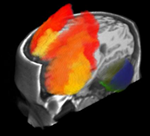Supplementary Material for bmm1512
Supplementary Material for bmm1512 (urn:nbn:de:0009-3-15126)
A Stereoscopic Volume Rendered Brain Atlas
*Corresponding Author: Address:A330 Cunningham Hall, KSU, Kent, Oh, 44224 USA Phone: +(330)672-2304 email: rclement@kent.edu
Licence: Any party may pass on this Work by electronic means and make it available for download under the terms and conditions of the Digital Peer Publishing Licence. The text of the licence may be accessed and retrieved via Internet at http://www.dipp.nrw.de/lizenzen/dppl/dppl/DPPL_v2_en_06-2004.html
-
Download VRBA [11.6 MB]
-
Alternative Resource: http://bioweb.biology.kent.edu/FacultyPages/Clements/resources/VolumeRenderedBrainAtlas.zip
-
If you receive an error when moving the slider to the fully "on" position you may need to install the MicrosoftTM speech engine available here [825 kb] .
-
Alternative Resource: http://bioweb.biology.kent.edu/FacultyPages/Clements/resources/spchapi.exe
Requirements
The software was compiled on windows XP but should work on windows 2000, XP and vista. It will also run on linux boxes under WINE (see http://www.winehq.org ) the windows emulation layer. The atlas is relatively computationally intensive and requires specific features on the local graphics processing unit (GPU). Specifically, the VRBA requires 3d and 2d OpenGL texture mapping extensions and graphics drivers supporting these functions (most modern GPU’s comply with these requirements). Processor speed will impact the responsiveness of the visualization, and anything below an Intel Pentium 4, 1.5 GHz, or AMD Athlon is not recommended. A screen resolution of 1280x1024 is required (anything less will clip some of the user interface), however higher resolutions are optimal (the interface was designed for 1920x1080; 1080p). In order to hear the text-to-speech (TTS) dictation of the brief descriptions, speakers or headphones are required with a functioning PC audio output system. Stereoscopic rendering also requires hardware: either anaglyph glasses, active shutter/ interlaced glasses, or a passive display setup. Active and passive modes should also be activated in the operating systems graphics drivers, and are dependant on the availability of quad buffered stereo on the installed GPU.
Acquisition and Installation
The volume rendered brain atlas is available for download as a compressed .zip archive of 11.3 Mb (see Article Resources ). Installation is straight forward and first involves extracting the folder from the compressed archive. An archive manager such as jZip ( free download here ), if one is not already available on the PC) should be used to extract the contents of the file to the desired location. Once extracted, a single directory named VolumeRenderedBrainAtlas is created. Within the folder is the executable (VRBA.exe) that runs the atlas.
-
Title: Volume Rendered Brain Atlas
-
Description: A 3D stereoscopically volume rendered brain atlas with 62 segmented brain structures. The atlas is fully interactive and contains brief verbal/written descriptions of the anatomical regions.
-
Language: English.
-
Authors: Robert Clements
-
Contributors: James L. Blank
-
Affiliation: Biological Sciences, Kent State University, Kent, Oh, USA 44242
-
Creator: Author
-
Publisher: Author
-
Source: Author
-
Rights: Author
-
Application context: education
-
Application setting: single or multi user.
-
Resource type: Rendered human brain atlas
-
Application objective: designed to create an easy to use interactive volume-rendered brain atlas that is compatible with virtual reality resources.
-
Required applications: eventually MicrosoftTM speech engine
-
Required platform: Windows 2000, XP, Vista; linux only under WINE (Windows Emulator, see http://www.winehq.org )
-
Requirements:
-
Archive: VolumeRenderedBrainAtlas.zip
-
Target-type: .exe
-
Target: /VolumeRenderedBrainAtlas/VRBA.exe
-
see section 'Usage' in the main article

